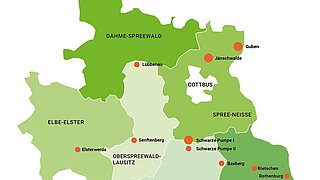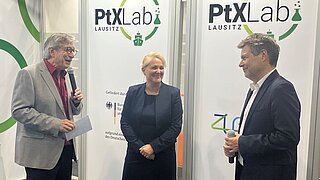Copyright: PtX Lab Lausitz
Scientific studies had previously filtered out the three most suitable locations in Lusatia. A new study now examines the final location where the production plant for synthetic paraffin should be built.
It is about 10,000 tonnes per year of green synthetic kerosene produced in a pilot plant in Lusatia. Where and how this can best be done will be illuminated in the coming months by a scientific study. In an open call for tenders, companies and research institutions were invited to apply to carry out the study. The winner was ARCUS Planung + Beratung, Bauplanungsgesellschaft mbH from Cottbus. Representatives of the company and the PtX Lab Lausitz met on 10 November at a first meeting to officially start the work.
Highest demands on sustainability
Dr. Harry Lehmann, head of the PtX Lab Lausitz, said of the study currently underway: "We want to build a plant for the production of synthetic kerosene in Lausitz that meets the highest feasible standards of sustainability. Examining the regional conditions at the three possible locations in detail with regard to this requirement is an enormously important basis for the selection of the location and for the subsequent operation. In this respect, we are very excited about the ARCUS analysis and look forward to be working together."
Four-month runtime on the way to a location
An investigation phase of four months in total is planned. During this time, a more in-depth examination of feasibility is to be carried out at the three sites that have been pre-screened - following a thorough scientific examination. The goal of the study is thus the "qualified determination of the most suitable site from a techno-economic point of view".
Subtasks here are numerous detailed investigations of the possible sites. This includes the determination of possible expansion paths for the supply of the required raw materials: How, for example, will the supply of CO2 and green hydrogen (H2) work out, especially with regard to the specified sustainability criteria? It should also be determined which technology or which technology mix for H2 and synthesis gas production can be used where and how.
Saving energy and producing as economically as possible
An evaluation of the product processing and an analysis of the optimisation of the yield of synthetic kerosene and by-products will prepare the dimensioning of the plant components. A modelling of the material and energy flows of the entire process already works in advance towards an efficient mode of operation. In this way, essential basics for the construction of the plant are already being investigated. This includes, for example, the question of how many and how efficient intermediate storage tanks would be necessary at the individual locations. Last but not least, the economic efficiency is also put to the test. With the analysis, ARCUS is shedding light on the production costs for the synthetic paraffin and the by-products. The study results as a whole will be an essential building block for the final selection of the site for the PtL pilot plant in Lusatia.

